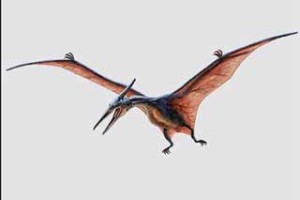Updated on: 28/03/2022
Pterodactyls, also referred to as Pterodactylus, is an extinct genus of pterosaurs that lived around 150 to 147 million years ago. The genus is currently known from a single species Pterodactylus antiquus. It is also the very first known pterosaur. Pterodactyls is often mistakenly confused with Pteranodon.
| Kingdom: | Animalia |
| Phylum: | Chordata |
| Order: | Pterosauria |
| Suborder: | Pterodactyloidea |
| Family: | Pterodactylidae |
| Genus: | Pterodactylus |
| Species: | Pterodactylus antiquus (Type Species) |
| Pronunciation: | Teh-roe-dack-till-us |
| Name Meaning: | Winged finger |
| Geological Time Period: | Early Tithonian, Late Jurassic Period |
| Size: | 2.5 to 3.1 ft. wide wingspan |
| Weight: | 2 to 10 pounds |
| Skull length: | 2 to 2.5 inches long |
| Range/Location: | Europe (England, France, Germany) and Africa (Tanzania) |
| Habitat: | Coastal environment, or near large water-bodies. |
| Diet: | Piscivore/Insectivore |
| Birth Type (Reproduction): | Eggs |
Pterodactyls is known from more than thirty fossil samples. Most of the skeleton remains belong to the juveniles. Smaller specimens, earlier thought as different species, are now believed to be juveniles of Pterodactyls antiquus.

The first fossil remains were found in the Solnhofen limestone of Bavaria in Germany. It was described in 1784, by Italian scientist Cosimo Alessandro Collini. The exact year of the specimen’s discovery is not known, but it is believed to be the earliest documented pterosaur discovery.
At first, it was first thought to be an aquatic creature. In fact, as late as 1830, a lot of the scientists used to believe that pterosaurs were aquatic creatures.
Pterodactyls was a lightly built flying reptile with a long skull. They had a short, rounded crest on the back of their skull. Some paleontologists believe that their crest was indicative of sexual dimorphism or age. Their brain was relatively large and they probably had good eyesight. It possessed a long, curved neck; and a long, straight and pointed jaw with small, sharp teeth. Tissue impressions in few specimens are significative of the presence of both a throat pouch and pycnofibres on the neck. Like all pterosaurs, Pterodactyls had light weighed, thin wings that took shape by a leather-like tissue layer stretched from the top of the legs to the elongated fourth finger. They also had a short tail, and its bones were hollow.
The name Pterodactyls has come from Greek words “pteron” meaning ‘wing’ and “daktulos” meaning ‘finger’. The name is thus because of its fourth fingers placed in its wing ridges.

It is believed that fish might have been on the top of their diet, and their long and pointed beak was quite helpful in catching its prey. Their feeding strategies varied as their dentition changed with age. So, this helped in reducing competition between two age groups. Researchers believe that they had a semi-upright stance. They could flap their wings and fly long distances. Comparisons between Pterodactylus antiquus’ scleral rings with those of the modern-day reptiles and birds suggest that they were probably diurnal.
| Pterodactylus antiquus | Valid, Type Species |
| Ornithocephalus antiquus | Synonym of Pterodactylus antiquus |
| Ornithocephalus brevirostris | Synonym of Ctenochasma elegans |
| Ptenodracon brevirostris | Synonym of Ctenochasma elegans |
| Pterodactylus brevirostris | Synonym of Ctenochasma elegans |
| Pterodactylus longirostris | Synonym of Pterodactylus antiquus |
| Macrotrachelus longirostris | Synonym of Pterodactylus antiquus |
| Ornithocephalus longirostris | Synonym of Pterodactylus antiquus |
| Pterodactylus “suevicus” | Synonym of Pterodactylus antiquus |
| Pterodactylus crocodilocephaloides | Synonym of Pterodactylus antiquus |
| Pterodactylus spectabilis | Synonym of Pterodactylus antiquus |
| Pterodactylus grandis | Nomen dubium, possible synonym of Rhamphorhynchus muensteri |
| Pterodactylus kochi | Synonym of Pterodactylus antiquus |
| Ornithocephalus kochi | Synonym of Pterodactylus kochi |
| Diopecephalus kochi | Synonym of Pterodactylus kochi |
| Pterodactylus meyeri | Synonym of Pterodactylus kochi |
| Ornithocephalus meyeri | Synonym of Pterodactylus kochi |
| Pterodactylus grandipelvis | Nomen dubium |
| Pterodactylus cerinensis | Nomen dubium |
| Pterodactylus suprajurensis | Nomen dubium |
| Pterodactylus manseli | Nomen dubium |
| Pterodactylus pleydelli | Nomen dubium |
| Pterodactylus arningi | Nomen dubium |
| Pterodactylus maximus | Nomen dubium |